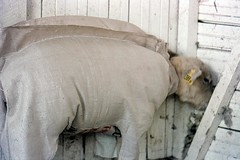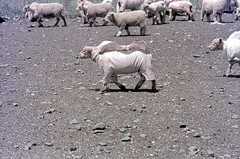Of course an empirical test is always available: spray a specimen with salt water and see if it dies. The salt-water vulnerability of menacing carnivorous plants (and other invading aliens) is an iron-cast law of nature, on account of the Morphogenic Resonance created by one or two precedents.
 None of this information was available to Keats and Chapman during their ill-fated attempt to make a quick fortune from sheep-farming in Chile, so their lack of skepticism is excusable. The pair were firmly convinced that earlier farmers had foundered not because the climate unsuited the arid high-country land for pastoral use, but
None of this information was available to Keats and Chapman during their ill-fated attempt to make a quick fortune from sheep-farming in Chile, so their lack of skepticism is excusable. The pair were firmly convinced that earlier farmers had foundered not because the climate unsuited the arid high-country land for pastoral use, but
 rather because the livestock would rub themselves against the local flora (as is the wont of itchy ovines), entangle their wool upon the spines, and inevitably perish. They were easily inveigled by an unscrupulous land-owner into taking out a lease on a large acreage, in the belief that they could safeguard sheep against this danger by sewing empty
rather because the livestock would rub themselves against the local flora (as is the wont of itchy ovines), entangle their wool upon the spines, and inevitably perish. They were easily inveigled by an unscrupulous land-owner into taking out a lease on a large acreage, in the belief that they could safeguard sheep against this danger by sewing empty
 fertiliser bags around them as crude jackets.
fertiliser bags around them as crude jackets.Chapman expressed some demurrals. He wondered whether the supply of fertiliser bags was sufficient.
"We don't have to wrap all the sheep," Keats confidently declared, "only the most valuable, most wool-producing of our stock."
"What about the second-rate ones?"
Keats was dismissive. "They don't come up to scratch."



6 comments:
"They don't come up to scratch."
Here there be monsters.
~
The salt-water vulnerability of menacing carnivorous plants (and other invading aliens) is an iron-cast law of nature, on account of the Morphogenic Resonance created by one or two precedents.
Hmmm... the high sodium content of urine must be a defense mechanism against carnivorous plants.
I CAN HAZ NOBEL??
Here there be monsters.
Worse, here be punsters!
Hey Smoot, you do well digging up covers to illustrate whatever it is they illustrate, but this may have some additional cover resources.
Not-a-robot made a sentence: "some rAGreed." It may be becoming sentient!
M. Bouffant's link to links will be a great boon to my research on visual allusions to Vermeer paintings in Schoenherr's cover art for Analog.
Also too now I want scans of the *internal* Kelly Freas illustrations for Pt 3 of the serialisation of "Satan's World" in Analog August 1968.
It is relevant to my interests.
Post a Comment